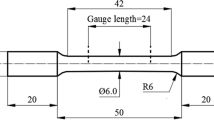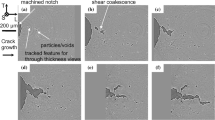Abstract
Originally Continuum Damage Mechanics and Fracture Mechanics evolved separately. However, when it comes to ductile fracture, an unified approach is quite beneficial for an accurate modelling of this phenomenon. Ductile materials may undergo moderate to large plastic deformations and internal degradation phenomena which are well described by continuum theories. Nevertheless in the final stages of failure, a discontinuous methodology is essential to represent surface decohesion and macro-crack propagation. In this work, XFEM is combined with the Lemaitre ductile damage model in a way that crack initiation and propagation are governed by the evolution of damage. The model was built under a finite strain assumption and a non-local integral formulation is applied to avoid pathological mesh dependence. The efficiency of the proposed methodology is evaluated through various numerical examples.
Similar content being viewed by others
References
Alfaiate J, Wells G, Sluys J (2002) On the use of embedded discontinuity elements with crack path continuity for mode-I and mixed-mode fracture. Eng Fract Mech 69(6): 661–686
Anderson TL (1991) Fracture mechanics: fundamentals and applications. CRC Press, Boca Raton
Andrade F (2011) Non-local modelling of ductile damage. PhD Thesis, Universidade do Porto
Andrade F, Cesar de Sa J, Pires FA (2011) A ductile damage nonlocal model of integral-type at finite strains: formulation and numerical issues. Int J Damage Mech 20(4): 515–557
Areias P, Cesar de Sa J, António CC (2003) A gradient model for finite strain elastoplasticity coupled with damage. Finite Elem Anal Des 39(13): 1191–1235
Areias P, Cesar de Sa J, António CC, Carneiro J, Teixeira V (2004) Strong displacement discontinuities and Lagrange multipliers in the analysis of finite displacement fracture problems. Comput Mech 35(1): 54–71
Areias P, Goethem NV, Pires EB (2011) A damage model for ductile crack initiation and propagation. Comput Mech 47: 641–656
Bažant ZP, Jirásek M (2002) Nonlocal integral formulations of plasticity and damage: survey of progress. J Eng Mech 128(11): 1119–1149
Belytschko T, Black T (1999) Elastic crack growth in finite elements with minimal remeshing. Int J Numer Methods Eng 45: 601–620
Benvenuti E (2008) A regularized XFEM framework for embedded cohesive interfaces. Comput Methods Appl Mech Eng 197: 4367–4607
de Borst R, Giessen E (1998) Material instabilities in solids. Wiley, New York
Cazes F, Coret M, Combescure A, Gravouil A (2009) A thermodynamic method for the construction of a cohesive law from a non local damage model. Int J Solids Struct 46: 1476–1490
Cazes F, Simatos A, Coret M, Combescure A (2010) A cohesive zone model which is energetically equivalent to a gradient-enhanced coupled damage-plasticity model. Eur J Mech A Solids 29: 976–989
Cesar de Sa J, Areias P, Zheng C (2006) Damage modelling in metal forming problems using an implicit non-local gradient model. Comput Methods Appl Mech Eng 195(48-49): 6646–6660
Chaboche J (1981) Continuum damage mechanics—a tool to describe phenomena before crack initiation. Nucl Eng Des 64(2): 233–247
Cottrell JA, Hughes T, Bazilevs Y (2009) Isogeometric analysis—toward Integration of CAD and FEA. Wiley, Chichester
Fagerström M, Larsson R (2008) A thermo-mechanical cohesive zone formulation for ductile fracture. J Mech Phys Solids 56(10): 3037–3058
Fries TP, Belytschko T (2010) The extended/generalized finite element method: An overview of the method and its applications. Int J Numer Methods Eng 84: 253–304
Geers M, Ubachs R, Engelen R (2003) Strongly non-local gradient-enhanced finite strain elastoplasticity. Int J Numer Methods Eng 56(14): 2039–2068
Huespe A, Needleman A, Oliver J, Sánchez P (2012) A finite strain, finite band method for modeling ductile fracture. Int J Plasticity 28(1): 53–69
Kachanov LM (1958) Time of the rupture process under creep condition. Izv Akad Nauk SSSR Otd Tekhn Nauk 8: 26–31
Korelc J. (2002) Multi-language and multi-environment generation of nonlinear finite element codes. Eng Comput 18: 312–327
Korelc J (2009) AceFem Users manual. www.fgg.uni-lj.si/symech/
Korelc J (2009) AceGen Users manual. www.fgg.uni-lj.si/symech/
Korelc J (2009) Automation of primal and sensitivity analysis of transient coupled problems. Comput Mech 44: 631–639
Lemaitre J (1985) A continuous damage mechanics model for ductile fracture. J Eng Mater Technol 107(1): 83–89
Lemaitre J (1985) Coupled elasto-plasticity and damage constitutive equations. Comput Methods Appl Mech Eng 51(1–3): 31–49
Lemaitre J (1996) A course on damage mechanics. Springer, New York
Lemaitre J, Chaboche JL (1990) Mechanics of solid materials. Cambridge University Press, Cambridge
Mazars J, Pijaudier-Cabot G (1996) From damage to fracture mechanics and conversely: A combined approach. Int J Solid Struct 33(20–22): 3327–3342
Mediavilla J (2005) Continuous and discontinuous modeling of ductile fracture. PhD Thesis, Technische Universiteit Eindhoven
Miehe C (1998) A constitutive frame of elastoplasticity at large strains based on the notion of a plastic metric. Int J Solid Struct 35(30): 3859–3897
Moës N, Dolbow J, Belytschko T (1999) A finite element method for crack growth without remeshing. Int J Numer Methods Eng 46: 131–150
Moës N, Stolz C, Bernard PE, Chevaugeon N (2011) A level set based model for damage growth: the thick level set approach. Int J Numer Methods Eng 86(3): 358–380
Moran B, Ortiz M, Shih F (1990) Formulation of implicit finite element methods for multiplicative finite deformation plasticity. Int J Numer Methods Eng 29: 438–514
Piegl L (1993) Fundamental developments of computer aided geometric design. Academic Press, San Diego
Pijaudier-Cabot G, Bažant Z (1987) Nonlocal damage theory. J Eng Mech 113: 1512–1533
Pijaudier-Cabot G, Bažant Z, Tabbara M (1988) Comparison of various models for strain softening. Eng Comput 5: 141–150
Seabra M, Cesar de Sa J, Andrade F, Pires F (2011) Continuous–discontinuous formulation for ductile fracture. Int J Mater Form 4(3): 271–281
Seabra M, Cesar de Sa J, Šuštarič P, Rodič T (2012) Some numerical issues on the use of XFEM for ductile fracture. Comput Mech. doi:10.1007/s00466-012-0694-x
Simo J, Taylor R, Pister K (1985) Variational and projection methods for volume constraint in finite deformation elasto-plasticity. Comput Methods Appl Mech Eng 51: 177–208
Simone A, Wells G, Sluys L (2003) From continuous to discontinuous failure in a gradient-enhanced continuum damage model. Comput Methods Appl Mech Eng 192: 4581–4607
Song JH, Wang H, Belytschko T (2008) A comparative study on finite element methods for dynamic fracture. Comput Mech 42(2): 239–250
Stolarska M, Chopp DL, Moës N, Belytschko T (2001) Modelling crack growth by level sets in the extended finite element method. Int J Numer Methods Eng 51: 943–960
Sukumar N, Prevost JH (2003) Modeling quasi-static crack growth with the extended finite element method part i: Computer implementation. Int J Solids Struct 40: 7513–7537
Author information
Authors and Affiliations
Corresponding author
Rights and permissions
About this article
Cite this article
Seabra, M.R.R., Šuštarič, P., Cesar de Sa, J.M.A. et al. Damage driven crack initiation and propagation in ductile metals using XFEM. Comput Mech 52, 161–179 (2013). https://doi.org/10.1007/s00466-012-0804-9
Received:
Accepted:
Published:
Issue Date:
DOI: https://doi.org/10.1007/s00466-012-0804-9




